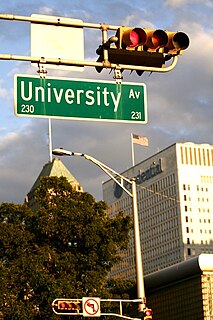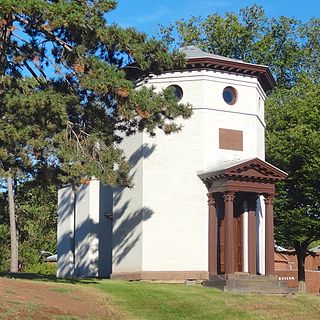
Cass Gilbert was a prominent American architect. An early proponent of skyscrapers in works like the Woolworth Building, Gilbert was also responsible for the Saint Louis Art Museum and Public Library; the Minnesota, Arkansas and West Virginia State Capitols; and the United States Supreme Court building. His public buildings in the Beaux Arts style reflect the optimistic American sense that the nation was heir to Greek democracy, Roman law and Renaissance humanism. Gilbert's achievements were recognized in his lifetime; he served as president of the American Institute of Architects in 1908–09.

Richardsonian Romanesque is a style of Romanesque Revival architecture named after architect Henry Hobson Richardson (1838–1886), whose masterpiece is Trinity Church, Boston (1872–1877), designated a National Historic Landmark. Richardson first used elements of the style in his Buffalo State Asylum for the Insane in Buffalo, New York, designed in 1870.

Henry Janeway Hardenbergh was an American architect, best known for his hotels and apartment buildings.

University Heights is a neighborhood in Newark in Essex County, New Jersey, United States. It is so named because of the location of four academic institutions within its boundaries — Rutgers University, the New Jersey Institute of Technology (NJIT), the New Jersey Medical School (Rutgers), and Essex County College. In total, the schools enroll approximately 35,000 degree-seeking students.

Downtown Newark is the Central Business District of Newark in Essex County, New Jersey, United States.

Bruce Price was an American architect and an innovator in the Shingle Style. The stark geometry and compact massing of his cottages in Tuxedo Park, New York, influenced Modernist architects, including Frank Lloyd Wright and Robert Venturi.

Rutgers–Newark is one of three regional campuses of Rutgers University, the public research university of the U.S. state of New Jersey, located in the city of Newark. Rutgers, founded in 1766 in New Brunswick, is the eighth oldest college in the United States and a member of the Association of American Universities. In 1945, the state legislature voted to make Rutgers University, then a private liberal arts college, into the state university and the following year merged the school with the former University of Newark (1936–1946), which became the Rutgers–Newark campus. Rutgers also incorporated the College of South Jersey and South Jersey Law School, in Camden, as a constituent campus of the university and renamed it Rutgers–Camden in 1950.
Charles Adams Platt was a prominent American artist, landscape gardener, landscape designer, and architect of the "American Renaissance" movement. His garden designs complemented his domestic architecture.

Old Queens is the oldest extant building at Rutgers University and is the symbolic heart of the university's campus in New Brunswick in Middlesex County, New Jersey in the United States. Rutgers, the Eighth-oldest college in the United States, was founded in 1766 during the American colonial period as Queen's College a decade before the start of American Revolution. Queen's College was named for Charlotte of Mecklenburg-Strelitz, the daughter of a German duke who became the queen consort of British king George III. Old Queens is located on a six-acre hilltop city block bounded by Somerset Street, Hamilton Street, College Avenue and George Street that was previously an apple orchard. Donated to the college in 1807 by James Parker, Jr., this city block become known the Queen's Campus and is the historic core of the university. Because of this, by metonymy, the name "Old Queens" came to be used as a reference to Rutgers College and is often invoked as an allusive reference to the university or to its administration.

Voorhees Mall is a large grassy area with stately shade trees on a block of about 28 acres (0.11 km²) located on the College Avenue Campus of Rutgers University near downtown New Brunswick, New Jersey. An eclectic mix of architectural styles, Voorhees Mall is lined by many historic academic buildings. The block is bound by Hamilton Street, George Street (north), College Avenue (south) and Seminary Place (west). At the mall's western end, across Seminary Place, is the campus of the New Brunswick Theological Seminary, whose history is intertwined with the early history of Rutgers University. Across Hamilton Street is the block called Old Queens, the seat of the university.
Rutgers University is an institution of higher learning with campuses across the State of New Jersey its main flagship campus in New Brunswick and Piscataway, and two other campuses in the cities of Newark and Camden, New Jersey.

Robert Henderson Robertson was an American architect who designed numerous houses, institutional buildings and churches.

Lockwood de Forest was an American painter, interior designer and furniture designer. A key figure in the Aesthetic Movement, he introduced the East Indian craft revival to Gilded Age America.
Van Campen's Inn or Isaac Van Campen's Inn is a fieldstone residence that was used as a yaugh house during the American colonial era. Located in Walpack Township, New Jersey along the Delaware River, it is a historic site located along the Old Mine Road in the Delaware Water Gap National Recreation Area. It is operated under a memorandum of understanding between the National Park Service and the Walpack Historical Society, a local non-profit corporation.
The following is a timeline of the history of the city of Newark, New Jersey, United States.

Geology Hall, formerly Geological Hall, is a building located in the historic Queens Campus section of Rutgers, The State University of New Jersey's College Avenue Campus in New Brunswick, New Jersey, United States. As part of the Queen's Campus, Geology Hall was included on the New Jersey Register of Historic Places and the National Register of Historic Places in 1973. When Rutgers was selected as New Jersey's only land grant college in 1864, the college began to expand its curriculum to include instruction in science and agriculture. Rutgers president William Henry Campbell raised funds to construct a building to accommodate this expansion, and Geology Hall, designed by architect Henry Janeway Hardenbergh, was built in 1872.

The Daniel S. Schanck Observatory is an historical astronomical observatory on the Queens Campus of Rutgers University in New Brunswick, New Jersey, United States. It is located on George Street near the corner with Hamilton Street, opposite the parking lot adjacent to Kirkpatrick Chapel, and to the northeast of Old Queens and Geology Hall.


















